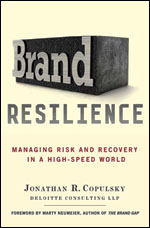 Imagine taking the US Military Field Manual for Counterinsurgency, putting it into Google Translate and converting it into brand speak. The result would be Brand Resilience: Managing Risk and Recovery in a High Speed World by Jonathan R. Copulsky.
Imagine taking the US Military Field Manual for Counterinsurgency, putting it into Google Translate and converting it into brand speak. The result would be Brand Resilience: Managing Risk and Recovery in a High Speed World by Jonathan R. Copulsky.
We’ve often heard of marketing compared to warfare, but that’s old school. Now, with social media amplifying and accelerating messages, the concept of protecting your brands using counter insurgent tactics is really quite brilliant.
Think about it; Are you protecting your brand?
“Yes, I have a crisis communication plan” is not enough. Do you have a plan to protect your greatest asset, one that is built on trust and credibility?
Copulsky, CMO for the Deloitte Consulting Strategy and Operations Practice, walks readers through the process to develop a strategy that defends and offends your brand from the known and the unknown brand saboteurs.
What is the difference between marketing as warfare and marketing as counterinsurgency?
The first principle of warfare is to overwhelm your enemy. The second is to convey a sense of decisiveness and purpose. The third is to organize around well-executed campaigns. And the fourth is to plan and orchestrate their use of weaponry.
Sure that’s a good plan on paper – but what about the random assaults? The unknown enemies? How do you even know if you are under attack?
Look at what happened to Domino’s when it’s employees made a disgusting video of them making a pizza?
What if a major athlete you sponsor (cough, Tiger Woods) crashed into a fire hydrant opening a can of worms and revealing all sort of un-role model-like behavior? It is out of your control, but it affects YOUR brand because you are a major sponsor.
What if a musician makes a video that subsequently goes viral, attacking your company for not responding appropriately to a damaged guitar complaint?
When do you respond? When do you not? How do you know if something is going to explode on the Internet? How do you know when it will fizzle if you leave it alone?
Brand Reslience outlines seven steps for managing brand risk and recovery.
First, we gain an understanding of the value of brand equity and how much we have to lose when that brand is breached.
- Identify the brand threats, aka the brand saboteurs. They can come from within your organizational borders. Your employees, top level management, even the CEO.
- Identify threats outside your borders. Your customers, vendors, anyone in your supply and/or distribution chain, activists/ideologues, competitors, and yes, your sponsored celebrities.
- Galvanize the troops. Understand how to rally your advocates.
- There is still a lot of uncertainly; we can never prepare for the unexpected fully. Copulsky makes us think about the early warning signs and try to assess if something is going to blow up or not. Should we respond to this or that? And when do you defend your position or step down and apologize and compensate.
- Understand how to repel the attacks. For example, Proctor and Gamble firmly stood their ground when they came under attack from moms who thought the new diapers were giving their babies diaper rash. They did regular testing and knew their product was not the cause of the problem. It was eventually proven to be true. I love the story of Hootsuite, who apologized to its premium customers for the Amazon server outage by and gave them credits even when the outage was completely out of their control.
- Learn and adapt your brand defenses.
- Measure and track.
There are so many factors at play today in protecting our brands. This book does a lot to make us think about putting processes in place and protecting one of the highest valued, but least protected assets in your company.
What do you do to protect your brand?
Thank you to Palgrave MacMillan for providing us a complimentary book to review. The links are not affiliates.